
The Upper West Side (UWS) is a neighborhood in the borough of Manhattan in New York City. It is bounded by Central Park on the east, the Hudson River on the west, West 59th Street to the south, and West 110th Street to the north. The Upper West Side is adjacent to the neighborhoods of Hell's Kitchen to the south, Columbus Circle to the southeast, and Morningside Heights to the north.
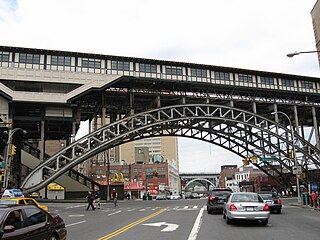
125th Street, co-named Martin Luther King Jr. Boulevard, is a two-way street that runs east–west in the New York City borough of Manhattan, from First Avenue on the east to Marginal Street, a service road for the Henry Hudson Parkway along the Hudson River in the west. It is often considered to be the "Main Street" of Harlem.

Parkchester is a planned community and neighborhood originally developed by the Metropolitan Life Insurance Company and located in the central Bronx, New York City. The immediate surrounding area also takes its name from the complex. Its boundaries, starting from the north and moving clockwise, are East Tremont Avenue to the north, Castle Hill Avenue to the east, Westchester Avenue to the south, East 177th Street/Cross Bronx Expressway to the southwest, and the Bronx River Parkway to the west. Metropolitan Avenue, Unionport Road, and White Plains Road are the primary thoroughfares through Parkchester.
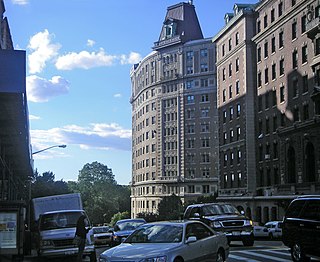
116th Street runs from Riverside Drive, overlooking the Hudson River, to the East River, through the New York City borough of Manhattan. It traverses the neighborhoods of Morningside Heights, Harlem, and Spanish Harlem; the street is interrupted between Morningside Heights and Harlem by Morningside Park.

Jerome Avenue is one of the longest thoroughfares in the New York City borough of the Bronx, New York, United States. The road is 5.6 miles (9.0 km) long and stretches from Concourse to Woodlawn. Both of these termini are with the Major Deegan Expressway which runs parallel to the west. Most of the elevated IRT Jerome Avenue Line runs along Jerome Avenue. The Cross Bronx Expressway interchanges with Jerome and the Deegan. Though it runs through what is now the West Bronx neighborhood, Jerome Avenue is the dividing avenue between nominal and some named "West" and "East" streets in the Bronx; Fifth Avenue, and to a lesser extent, Broadway, also splits Manhattan into nominal "West" and "East" streets.
The Weylin Hotel was a hotel at 527 - 531 Madison Avenue and 40 - 54 East 54th Street in New York City. It was on the southeast corner of 54th Street. The structure was sixteen stories tall and opened in March 1921. The building fronted sixty-one feet on Madison Avenue and one hundred forty-eight feet on 54th Street. It contained 125,000 square feet (11,600 m2) of space.

The Allerton Hotel for Women, today known as Renaissance New York Hotel 57, is a hotel located at 130 East 57th Street in the New York City borough of Manhattan. It is a seventeen-story brick, limestone, and terra cotta building designed by Arthur Loomis Harmon in 1920. It was built on the southwest corner of Lexington Avenue and 57th Street by the Allerton House Company at a cost of $700,000. It originally had stores on its ground floor. The hotel intended to accommodate six hundred business and professional women and also shelter young girls. When completed in 1923, the Allerton Hotel had room for four hundred tenants. Its occupancy was filled prior to completion and there was a long waiting list. After opening it was so popular that another establishment of its kind was anticipated.

The Marbridge Building is an office establishment at 1328 Broadway, on the east side of Sixth Avenue between 34th and 35th Streets in Herald Square, Manhattan, New York City. It opened in 1909, an 11-story building, utilized in part by Rogers Peet. Until October 1910 it stood opposite the Alpine apartment house, which was at the northeast corner of Broadway and 33rd Street. The Alpine and old stores between 33rd and 34th Streets were demolished to make room for the $5,000,000 Hotel McAlpin near the end of 1910. On the other side of Broadway were located the Macy's Herald Square and Saks Incorporated stores, with the Gimbels store just below.
The Studebaker Building is a former structure at 1600 Broadway on the northeast corner at 48th Street in Manhattan, New York City. It was erected by the Juilliard Estate, in 1902, between Broadway and 7th Avenue, in the area north of Times Square. It was demolished in 2004 to make room for an apartment tower, a twenty- five story, 136 unit, luxury condominium designed by architect Einhorn Yaffee Prescott.
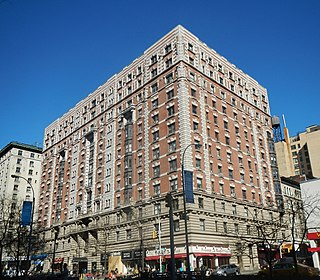
Bretton Hall is a twelve-story residential building at 2350 Broadway, spanning from West 85th to 86th Street on the Upper West Side of Manhattan, New York City.

Congregation Rodeph Sholom is a Reform synagogue in New York City. Founded in 1842 by immigrants from the German lands, it is one of the oldest synagogues in the United States.
The De La Salle Institute was a coed Catholic Church school which operated in Manhattan in New York City beginning in the 19th century. From 1902 it was located at 106 West 59th Street, running through to 107 West 58th Street. It fronted 59th Street for 53.5 feet (16.3 m) and faced Central Park. It had a depth of 200 feet (61 m), with 53 feet (16 m) on West 58th Street, and 71 feet (22 m) west on Sixth Avenue. In August 1912 the De La Salle Institute adjoined the German Club on West 59th Street and the Hotel Savilla on West 58th Street.
74th Street is an east–west street carrying pedestrian traffic and eastbound automotive/bicycle traffic in the New York City borough of Manhattan. It runs through the Upper East Side neighborhood, and the Upper West Side neighborhood, on both sides of Central Park.

George Willard Conable (1866-1933), AIA, was an American architect practicing in New York City in the early to mid 20th century specializing in churches.

998 Fifth Avenue is a luxury cooperative located on Fifth Avenue at the northeast corner of East 81st Street in the Upper East Side of Manhattan, New York City.
William A. Harris Garden is a .11-acre city-owned community garden in the Sugar Hill section of the Harlem neighborhood in New York City. It is located on the northwest corner of West 153rd Street and St. Nicholas Avenue.
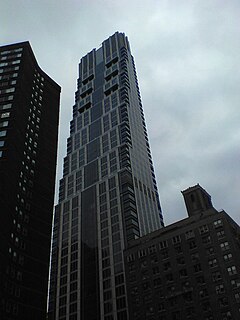
200 Amsterdam is a residential skyscraper at the intersection of Amsterdam Avenue and 69th Street on the Upper West Side in Manhattan, New York City. The lot was formerly occupied by the Lincoln Square Synagogue. The tower contains 112 condominiums.
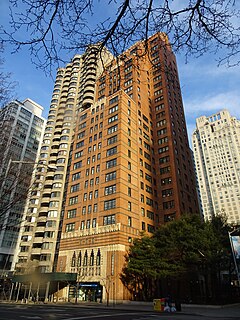
The Sofia is a condominium building at the corner of Columbus Avenue and 61st Street on the Upper West Side of Manhattan in New York City. It was constructed from 1929 to 1930 and was designed by the firm of Jardine, Hill & Murdock in the Art Deco style for Kent Automatic Garages. The Sofia is 27 stories tall; the first nine stories above the ground level are used as offices, while the top 17 stories contain residential condominiums. The building is a New York City designated landmark and on the National Register of Historic Places.
1020 Fifth Avenue is a luxury housing cooperative in the Upper East Side of Manhattan, New York City. It is located on the northeast corner of 83rd Street and Fifth Avenue, across the street from the Metropolitan Museum of Art's Fifth Avenue building. It is part of the Metropolitan Museum Historic District. Along with 1040 Fifth Avenue, 998 Fifth Avenue and 1016 Fifth Avenue, it is considered among the most prestigious residential buildings in New York City and is frequently included in lists of top residential buildings. Sales of units in the building are often reported by the press. Former New York Times architectural critic Carter Horsley describes the building as "[o]ne of the supreme residential buildings of New York". The building is profiled in multiple architectural books, including in Windows on the Park: New York's most prestigious properties on Central Park, where it is described as "one of the city's most exclusive addresses".














